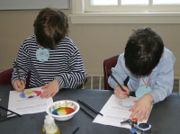Final edits
This looks good. I love the simplicity of the approach. Anything involving snow appeals to VT kids, and the connection to roads and road salt is also valuable. And what a cheap idea with excellent results!
Most important: You need photographs. And your handout needs a caption:
Formatting figures[edit]
Any photograph, map, diagram, or handout that is embedded in your wiki counts as a figure. Tables should be handled differently.
Adding numbered captions to your figures can simplify your writing. You can refer a reader to a picture as simply as this: (Fig 1). No need to say see below or to the right of this text, particularly when the figure may move depending on the window size in which the page is viewed. So, I suggest captions like this: Figure 1. Enough detail following the figure number to orient the reader to the image. Figure captions do not work well in the Rich Text editor, so it may be worth turning that off to edit captions. The following image and caption was added to this page using this syntax:[[Image:RainbowHypothesis.jpg|Figure 1: Students generating hypotheses|thumb]]
Once changes have been made, you should delete the text ''{{Figures}}''from your page.
Group materials[edit]
Mark the specific materials with an astrix, and add a foot note explaining that almost any granular material can be tested.
Suggest jars as cheap alternatives to beakers; glass jars might work better because the nail will make a satisfying clink once the snow melts.
==Handouts==. Add a caption (see above)
==Description of activity==: I think it is important to mention that the nail should go point down into the snow. Otherwise you risk having the nail balance indefinitely on it's own head.
==inclass activities== In a full classroom situation one could allow student groups to select from a group of available materials or bring (safe) materials in from home (no black powder please).
There is a lot of white space. Cut that back and turn it into a bullet list (place a single astrix at the beginning of each line).
==Hypotheses, correct/incorrect etc==. I think it is better to discuss hypotheses in terms of being supported or rejected. Incorrect too easily equates with wrong, and a child's hypothesis is never wrong. We should emphasize that correctly rejecting a hypothesis is successful science (it's a little tough for many professionals, let alone a first grader, but worth establishing early).
Formatting citations[edit]
To insure that a reader can reliably track down the specific book or article you intended, it is useful to provide the following information:
- Author(s) (last name followed by first initials; secondary authors: initials followed by last name); year; Book title or article title; publisher (for books) or Periodical title (for articles); volume and page numbers (both for articles)
Formatted examples:
- Brown, M.W. and C. Hurd. 1947. Goodnight Moon. Harper.
- Bentley, W.A. 1905. Studies of raindrops and raindrop phenomena. Monthly weather review. 32. 450
Once changes have been made, delete the following text: {{citations}}
17:58, 11 February 2009 (UTC)
